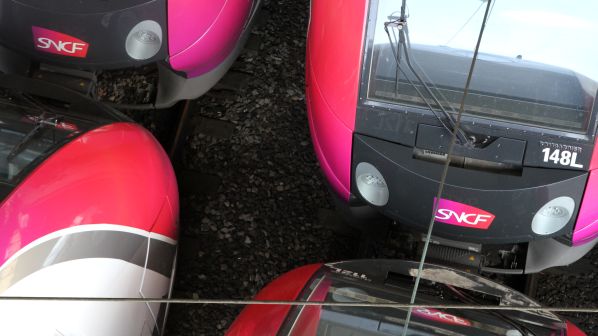“IN the next three to four years, there will be more changes at SNCF than in the past 30 years,” Mr Guillaume Pepy, French National Railways’ (SNCF) president and CEO told journalists at the Innovmat event held at the railway’s Saint Denis headquarters on February 6.
While this is arguably true with regard to market opening and reforms to the railway in France, it is most definitely the case concerning innovation and the deployment of new digital technologies.
Pepy revealed that SNCF’s deputy CEO and chief technology and railway systems officer, Mr Pierre Izard, recently told him that it is almost scary how much the company is going to change. This is both the result of new technologies that SNCF is already working with or developing, or those that will emerge over the next few years as new concepts such as 5G telecommunications and Artificial Intelligence become available.
For Pepy and Ms Carole Desnost, SNCF’s chief innovation officer, success is dependent on both adopting these new technologies and a radical change in how SNCF innovates and engages with the supply sector. Pepy says the days of “cherry picking” specific technologies are over and SNCF is now embracing a motto of being open to working with the wider world. Desnost agrees, and says in practice this means working alongside suppliers early on to develop the building blocks for key transformative projects.
“We are willing to run the risk with experimentation,” Desnost says. “When it comes to our vision for the future and our strategy, our ambition is to contribute to the train of the future, which is going to be connected, which is going to be autonomous, which is going to be zero emissions. Of course, it looks very simple, but what we need to do to achieve this is quite mind-blowing. It means radical change in the way we think about signalling, train-to-train communication, and so on.”
SNCF launched its digital transformation strategy - subsequently branded #DigitalSNCF - in 2015. The railway’s Innovation and Research department is at the heart of this change while its Tech4Rail programme is providing the means through which SNCF is exploring new disruptive technologies. This includes the Internet of Things, connected and autonomous cars, robotics, additive manufacturing, big data and artificial intelligence. SNCF is also engaged in Europe’s Shift2Rail programme as an associate member working on three innovation programmes.
The Innovmat event offered insight into some of the current projects to achieve this vision with regard to rolling stock, including details of SNCF’s ATO project and plans to introduce hybrid trains.
Under this project, which was agreed in mid-2018, Alstom will retrofit a Regiolis bi-mode train so it is capable of switching between battery power, diesel traction and electric traction from the catenary. Two of the train’s four diesel engines will be replaced with lithium-ion batteries which will harness and store power from both regenerative braking and overhead catenary. Alstom says the goal is to reduce the train’s power consumption by 20%.
The potential for the project is significant given expected demand - around half of SNCF’s DMUs are more than 20-years-old and due for replacement in the next decade.
In particular, roughly 50% of the approximately 2300-strong TER fleet, which accounts for 40% of all train-km operated, is diesel while 20% is dual-mode electric and diesel.
Emphasising their desire to speed up the innovation process, the partners in the project have set the ambitious target of introducing two hybrid trains into commercial service by 2021 with a view to a full roll out in 2022. Desnost says the project’s collaboration model also shows that the railway is no longer approaching such projects by “just putting money on the table.” Three French regions - Grand-Est, Nouvelle-Aquitaine, and Occitanie - along with Alstom have contributed to the €16.6m cost while Occitanie is providing access to its fleet.
“The way of doing this project is much quicker than a call for tender,” Desnost says. “It is another way to better understand this new technology and not just get a patchy view of things, but the bigger picture. We can then use this experience to replace the fleet of regional trains because we know this is bound to happen.”
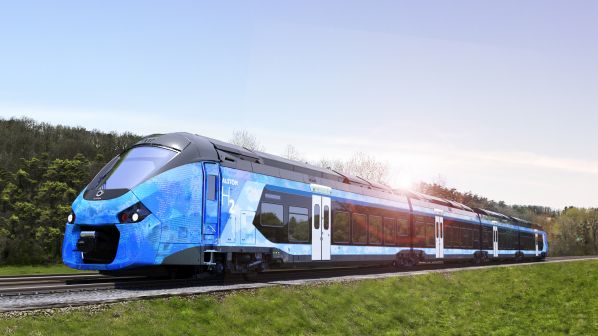
SNCF is adopting a similar model for its hydrogen train project, which is also earmarked to replace the diesel fleet. A feasibility plan was announced by SNCF at a meeting with the French regions in December shortly after Alstom announced plans to adapt its Coradia iLint platform for use in France.
Desnost says that as a “first of its kind train,” SNCF is looking to work closely with local governments interested in the concept as well as other industries. She says Occitanie has expressed an interest in testing the concept and this will be carried out within the context of a contract between SNCF and regions. She adds that hydrogen suppliers are also engaged and the hope is to develop wider hydrogen infrastructure not only for trains but other transport modes.
“You need sites for taxi fleets, for buses, and trains,” Desnost says. “We are currently exploring the regions where local governments are committed to this to see how we can deploy the hydrogen train. We want to have a complete ecosystem in place.”
The ATO project is adopting a similar collaborative approach between the railway and industry. SNCF is working alongside 10 suppliers - all with different experiences - in two consortia on passenger and freight projects with all participants contributing to the e57m cost. The objective is for the first main line deployment in 2021 and a commercial rollout from 2025. If successful, ATO is forecast to offer a capacity gain of 20-30%, a potential game changer for the railway.
Likewise, SNCF has altered its approach to working with the start-up sector. Desnost says instead of waiting for companies to present their ideas, SNCF is investing in small tech companies in order to experiment with ideas and develop projects relevant to the railway’s digital objectives.
Mr Benoit Tiers, head of SNCF’s digital business unit, says the railway offers start-ups a three-month programme to develop ideas. At the end of this process, SNCF has the option to invest in the company directly or as a partner in a capital investment fund. The railway has so far invested in 11 start-ups which are working in the new mobility, customer service or big data fields. Tiers believes they can provide the means to assist with anything from developing a digital twin of SNCF’s infrastructure to better serving passengers.
“Yesterday mobility was only about station-to-station,” Tiers says. “Today our customers want to have personal recognition and want us to provide additional services that add to their mobility experience. Our work with start-ups can help to develop situations that will optimise this relationship.”
Factory of the future
As SNCF works on a €400m project to overhaul or replace 10 key workshops over the next few years, a major emphasis of Innovmat was to showcase the “Factory of the future.”
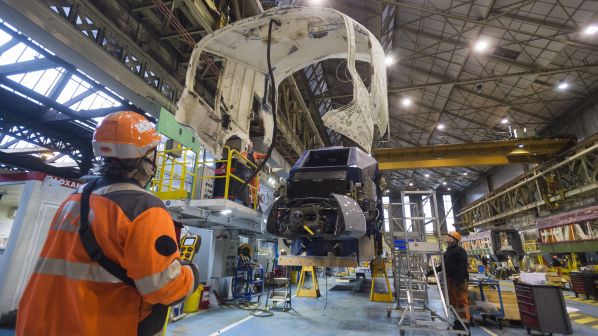
As well as daily maintenance, SNCF’s workshops are responsible for tasks such as converting TGV Duplex sets to Ouigo specification; installing Wi-Fi on regional and inter-city trains; or performing transformer conversions for tram-trains.
Three new depots will be inaugurated this year - Hellemmes, Romilly-sur-Seine and Vénissuex, which will replace Oullins depot near Lyon. According to Mr Xavier Ouin, SNCF’s chief rolling stock officer, these sites will showcase the maintenance workshop of the future, including many of the technologies on show at the exhibtion (see panel). Many of the new and retrofit projects are likewise harnessing Building Information Modelling (BIM) to enhance the design of the building and the shop floor and the efficiency of the tasks taking place.
“A few years ago we noticed that maintenance volumes went down by 50% at our workshops so we understood that we would have to move away from the 19th or 20th century workshop model and deploy new technologies,” Ouin says. “We had to start from scratch. We have had to retrain operators. But it was great because we turned to our engineers and asked what they want from these new shop floors.”
All operators now have access to a tablet, which offer user-friendly applications to improve access to key documents as well as enabling technicians and operators to key in diagnostics and other information in real-time. Young people, or digital natives, have served to bring older staff up to speed. In turn, these empowered operators and technicians are increasingly providing direct input to develop new and improved work processes that use new technologies. This process is aided by “Fab Labs.” Here technicians can work alongside experts to harness equipment such as 3D printers to turn their ideas into reality.
Ouin says taking such an approach has helped to alter employees’ views of new technology and its role in the workplace. “In the past robots were confined to some areas and were considered as a means to reduce employment,” Ouin says. “This has changed. Now it is more likely that robots are viewed as just an assistant and as something that helps to preserve staff health, which is very positive.”
As well as shop floor staff, SNCF is working to attract and mould the level of expertise necessary to lead innovation projects. A specialist recruitment programme for the Innovation and Research department is in place to recruit bright and talented people from technical schools and colleges. Desnost says this is not proving difficult because these individuals are inspired by the level of innovation taking place. She says the idea is for these new recruits to stay within her team for five to six years with a view to eventually leading a new team working on a specific project.
While leveraging in-house knowledge and skills is important to use new technologies effectively, it is also essential to maintain SNCF’s competitive position. New data-driven technologies are presenting new business models, altering the relationship between the railway and its suppliers. More and more suppliers are offering “software as a service” platforms, which require the railway to enter into a subscription agreement, rather than traditional off-the-shelf solutions.
However, Ouin says the moment this subscription ceases, the supplier stops providing what could be critical information feeding key processes, thus leaving the railway vulnerable to becoming stuck in a proprietary arrangement.
This is particularly apparent in train maintenance. With rolling stock now potentially fitted with thousands of sensors - Ouin says SNCF’s newest trains record 70,000 separate pieces of information everyday - it is imperative that SNCF remains in control of this information.
“We want to come up with our own solutions,” Ouin says. “We don’t want to be cash cows and not have a clue about the black box. Otherwise they may as well raise their prices, and whenever you want to turn to someone else because you want to get a cheaper rate, there is nothing you can do.”
With 1700 engineers working in-house, and 150 years of experience of maintaining trains, Ouin says the railway has the necessary expertise to develop suitable predictive maintenance programmes by itself to avoid the pitfalls of these relationships. SNCF has recruited its own data analysts who are working closely with maintenance experts to come up with suitable algorithms to deliver predictive maintenance, with the early fruits of this process now in practice on the Transilien suburban network in Paris.
Here, 250 trains are fitted with a wide range of sensors and fault diagnostics systems, which measure anything from the train’s operating speed and the health of the battery to the status of the passenger doors or the temperature in a particular coach. The trains are in constant communication with the Transilien Driving Support Centre (Pact) at Saint Pierre des Corps, and in the event of a problem with a door, for example, staff are alerted by different signals, with red indicating an immediate problem and orange informing engineers that the door should be inspected during the next regular maintenance interval. Virtual reality applications can also guide the driver to solve the problem on the spot.
SNCF estimates that the programme has halved failures resulting in delays of less than 20 minutes, and that there are three-times fewer failures leading to major disturbances in densely-populated areas. “Predictive maintenance is the talk of the day and it is a reality for us,” Ouin says. “If you compare ourselves with Japan, Korea or even China, we are not lagging behind.”
Ouin says taking on this challenge in-house reflects what is no longer a black-and-white relationship with suppliers; on some projects such as the hybrid or hydrogen train projects and ATO, SNCF will collaborate with these companies. On others such as providing maintenance services it will increasingly compete with them.
Becoming an innovator in its own right may also give SNCF the upperhand when it comes to staying competitive in the general transport sphere, particularly with regard to automation.
Well placed
Other modes are actively exploring similar projects, which could free-up capacity on congested roads and potentially threaten rail’s attractiveness for offering high-volume transport. However, Desnost feels that by embracing the challenge head on and by taking the lead SNCF is now well placed to meet any potential threat.
“Railways have several assets versus other transport modes,” she says. “We are used to intelligent infrastructure and smart communications and we think the transition period will be easier for us. We will be ahead of autonomous cars because we have experience with intelligent communications. When it comes to batteries and hydrogen trains, the applications are well defined in a railway system and maybe we will be able to test these technologies more quickly.”
The digital strategy is providing SNCF with the autonomy to embrace and not shirk from generation-defining change. More exciting developments are just around the corner.
Innovmat innovations
ONE of the most eye-catching exhibits from the Innovmat exhibition was an Automated Ground Vehicle (AGV). Dubbed Wall-E, after the Pixar film character, and developed in partnership with the Twinswheel start-up, the vehicle transports spare parts from the storage area to predefined locations around the workshop following a set path.
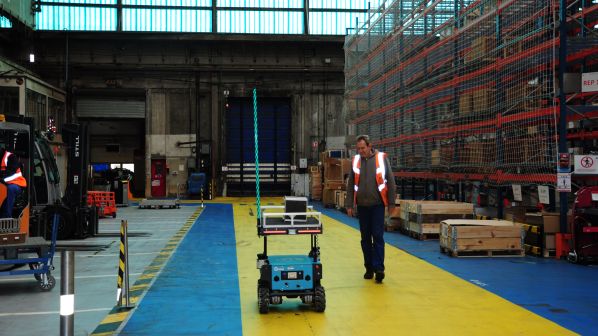
Employees responsible for issuing spares place them on the vehicle and choose the destination using the touchscreen reader. The idea is for the AGV to reduce the burden for depot employees by eliminating journeys to and from the storage area and to carry potentially heavy and awkward components for prolonged periods of time.
More and more of the components delivered by AGV will be produced using additive manufacturing or 3D printing. SNCF is exploring use of the technique to avoid problems with spare part obsolescence and to speed up the production and procurement process.
The railway is also looking at other ways to simplify existing tasks. This includes utilising intelligent robots, developed alongside start-up Isybot, for tasks such as industrial sanding and repainting rolling stock, and deploying drones to monitor the condition train roof condition. Drone send images to tablets used by engineers at the depot who are able to identify any issues worth further investigation just as easily as if they had to clamber on the roof to inspect the train manually.
Another prominent example on display during Innovmat was an exoskeleton bodysuit, which was demonstrated following two years of work. Developed in partnership with Ergosanté Technology, the latest version of the suit offers employees five-in-one functionality and is designed to reduce the strain on the body during heavy lifting of components such as brake blocks, which can weigh up to 30kg, as well as to help employees better use tools.
The developers have worked closely with potential users to assess their needs with around 20 people testing the initial prototype, and the design and functions of the system matching the different types of motion the user is expected to execute. Development of the exoskeleton is continuing but it is hoped that SNCF workshop employees will begin using the concept from July.
Beyond the workshops, several projects which are facilitating SNCF’s shift to a predictive rather than reactive train maintenance regime were on show.
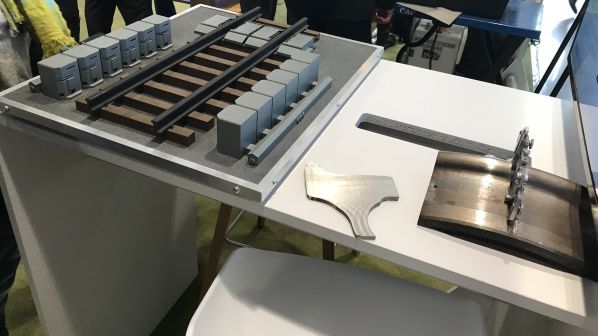
This includes a TGV inspection testbench, which is able to detect issues with the 26-30 wheelsets and associated equipment on a conventional TGV train. The system identifies potential problems with axles and brake systems as well as measuring the diameter and flange of the wheel and defects on the wheel surface such as flats. The goal is to replace all of the manual and visual inspection tests, which can take engineers up to a day to perform, with the test bench completing the inspection within 25 seconds, and potentially offering dramatic improvements to rolling stock availability.
A trial system is currently in use at Technicentre Atlantique in Paris where engineers are set to continue assessing the system’s performance throughout 2019 as the concept is rolled out across four other locations in France. The hope is for main line installations to perform the tests with trains travelling at up to 100km/h. In addition, while assessments are currently performed using a specific interface, there are plans to incorporate this with the computerised maintenance management system (CMMS). Developers also hope to extend inspection to the carbody, underframe and pantographs as well as extend use to other train fleets.
Another pilot project that could offer significant improvements in conditions for passengers, specifically air quality at stations, is also underway on the Transilien network. Tallano Technologies is assisting SNCF to install a vacuum cleaner on the trains to remove brake dust particles, which can prove particularly problematic at stations. Wheelsets drive suction turbines mounted under the train, which are triggered during braking. Particles from the brake discs are collected via hoses and stored. SNCF will move ahead with a pilot on two EMUs from October with the project running until July 2021. The goal is to reduce these particulate emissions by 70%.
Other highlights from the exhibition include a new hand-held probe for ultrasonic inspection of potential faults on wheels and axles. Unlike the current system, which uses a gel to provide adequate contact between the probe and the wheel, the Aquasan devices use a water-based lubricant. An improved pantograph current collector system was also presented. Consisting of four parallel carbon strips separated by a steel copper alloy bar, the device projects extending wear life 10-fold, saving SNCF around €1m per year.
Finally, Mitsubishi is working on a project to fit a new silent roof-mounted HVAC cooling system on Siemens tram-trains used on the Bondy - Aulnay line in Paris. The system eliminates the use of an electric fan, reducing noise emissions by around 13dB and power consumption by half. The transformer will also use hermetic seals, which will eliminate periodic maintenance of insulating oil.
Work on a prototype is now underway, and if the trials are successful, the system could be rolled out across the Bondy - Aulnay fleet.
